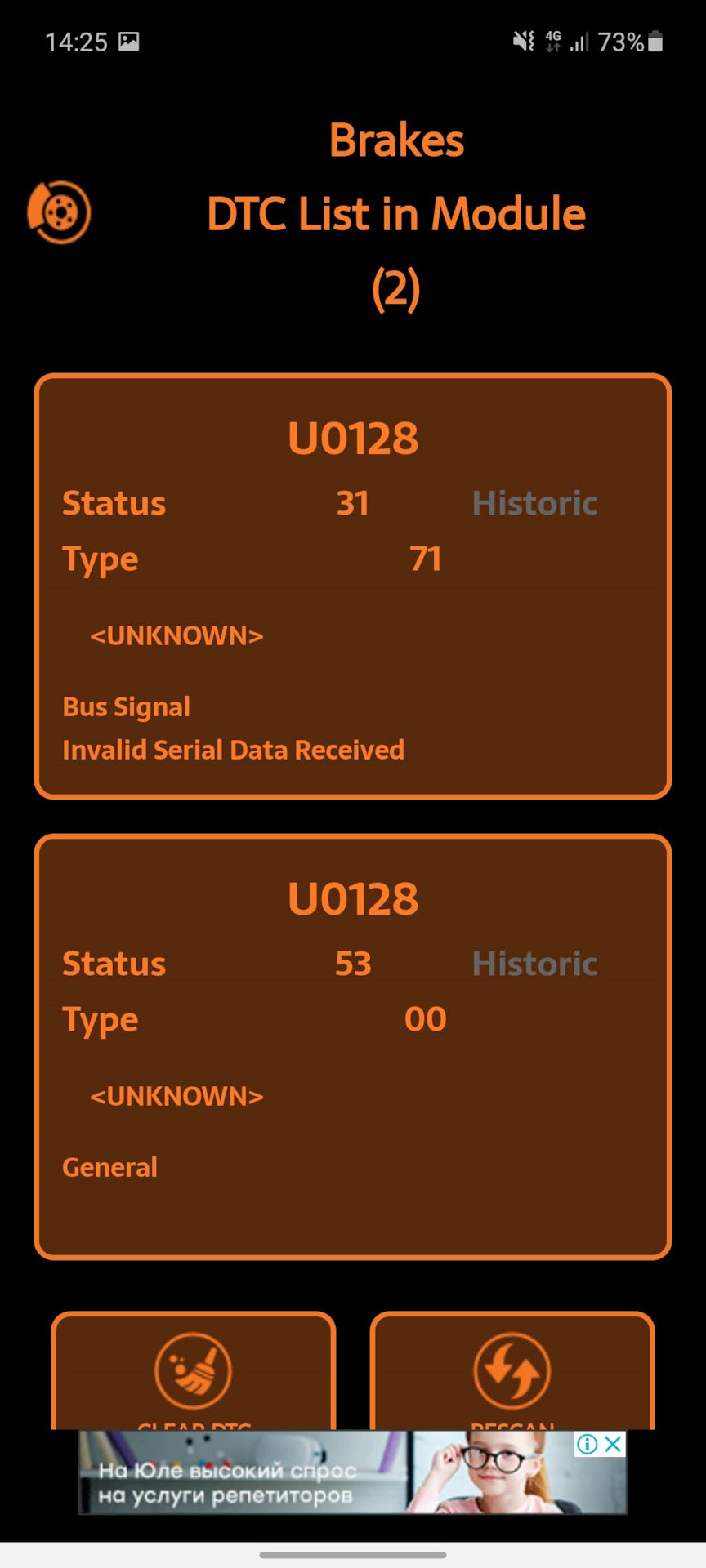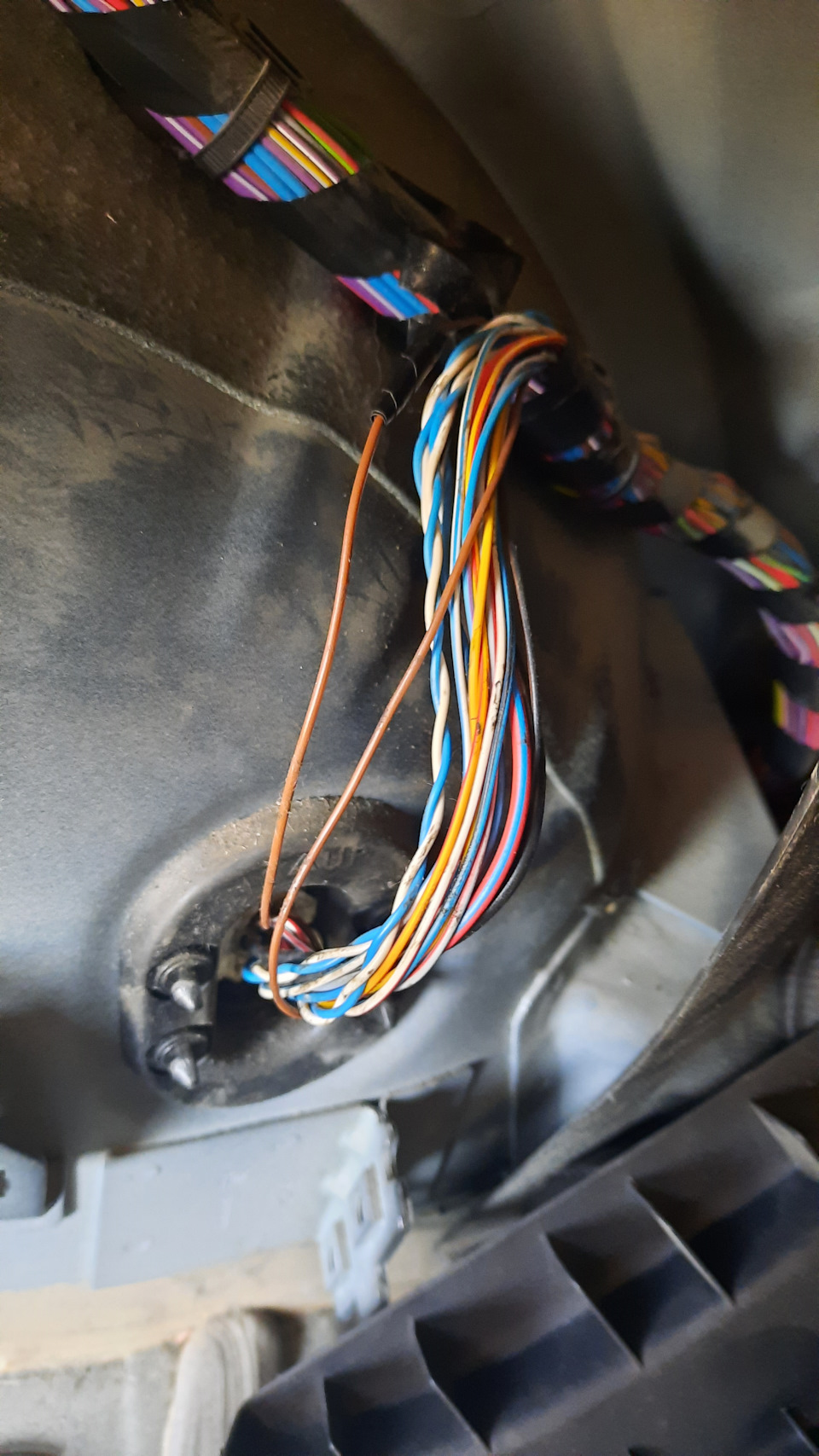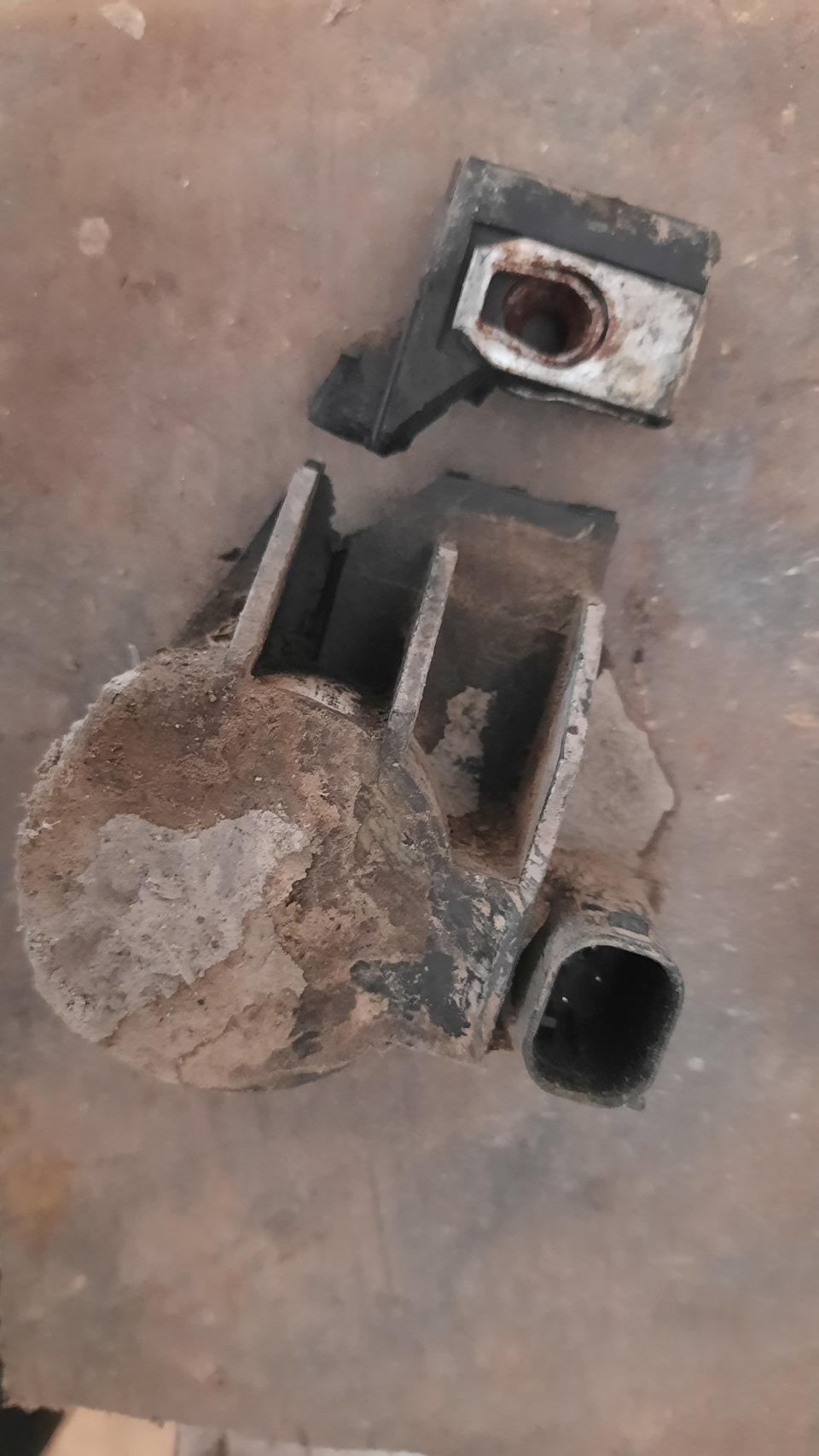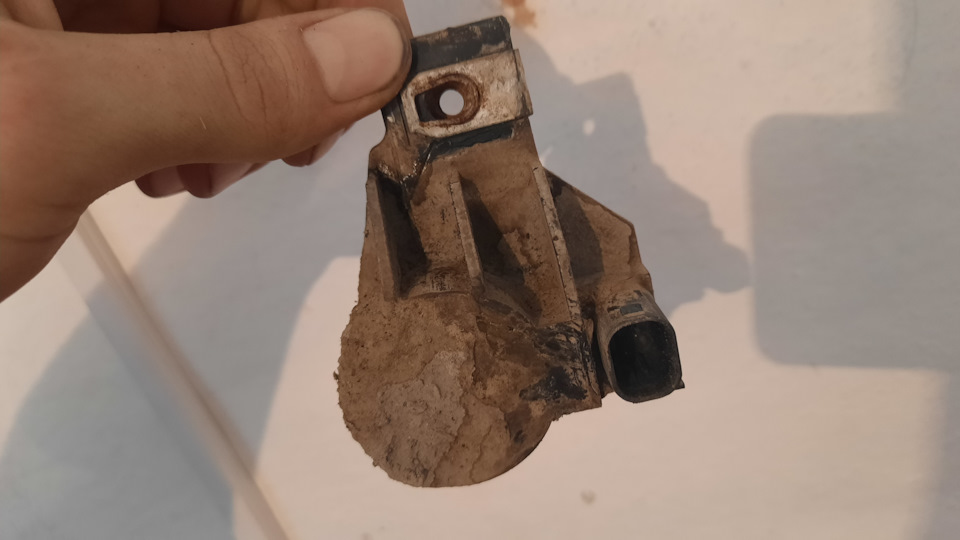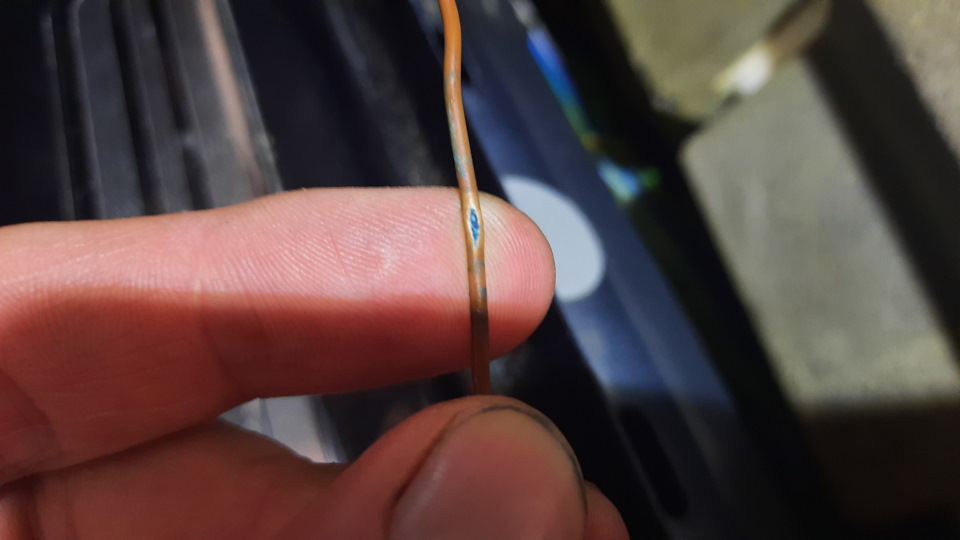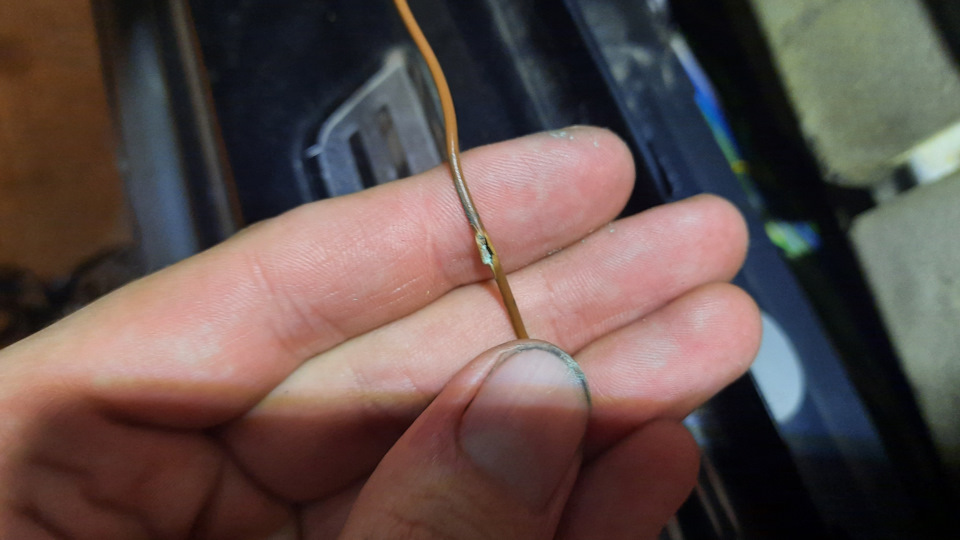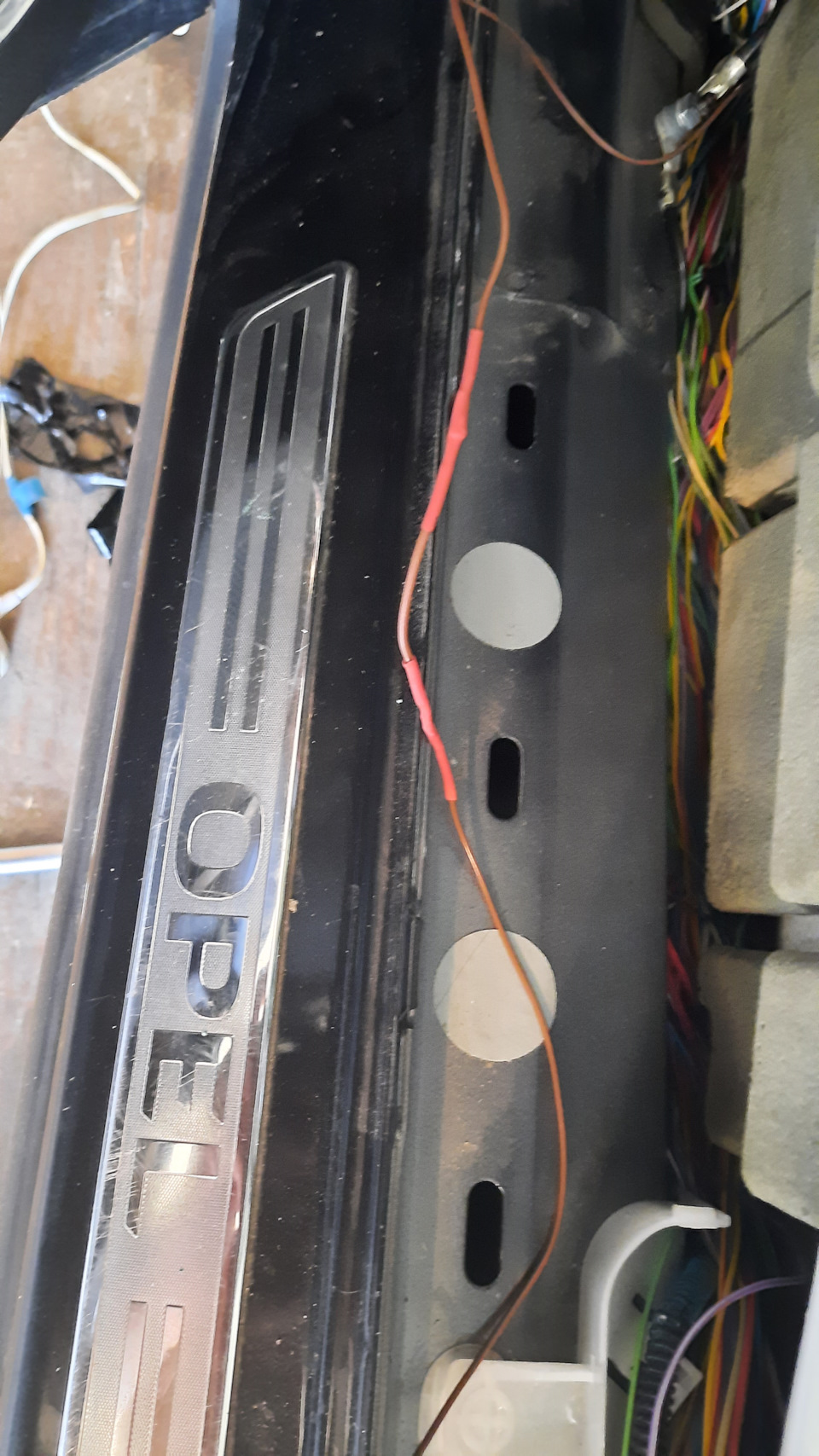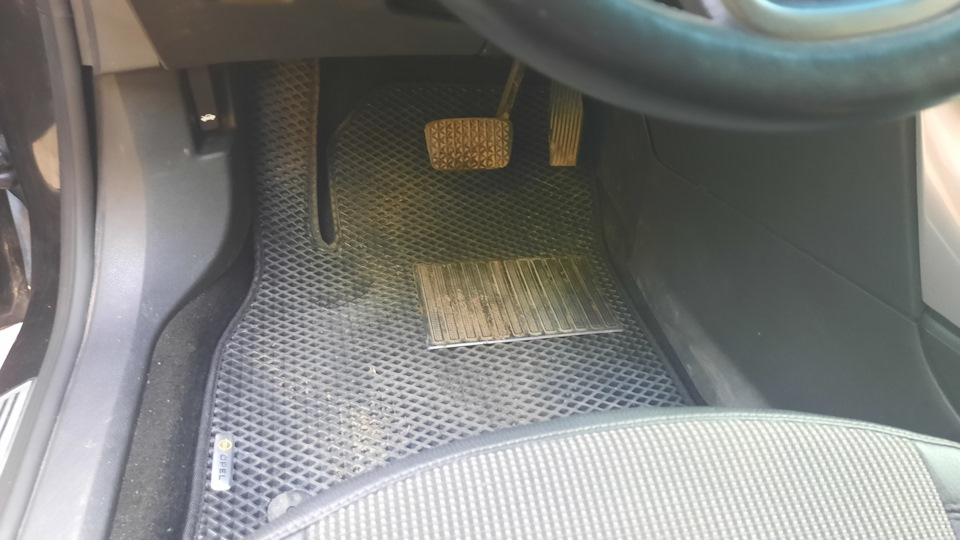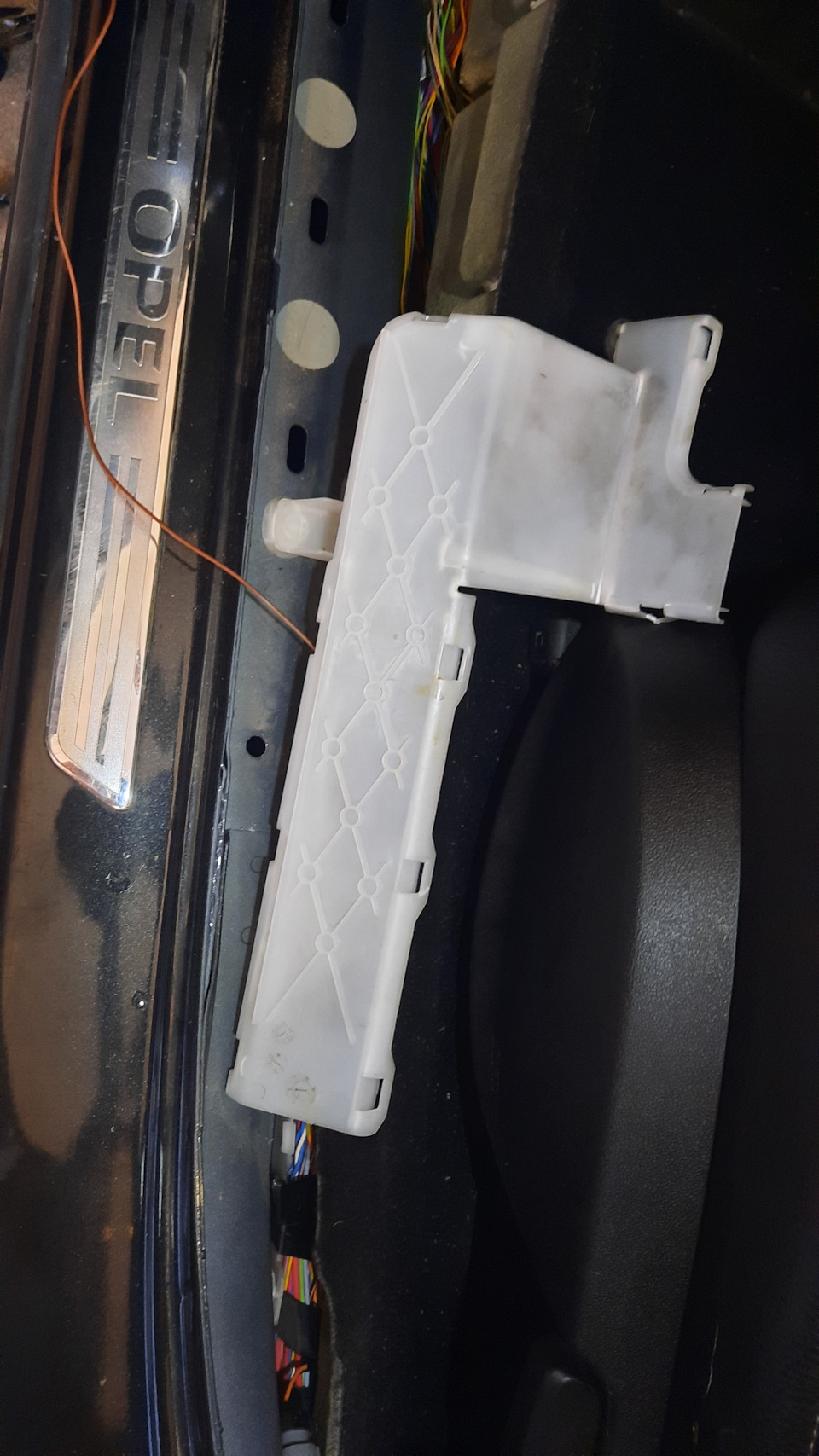Подытожим
Ошибка U0128 говорит нам о не работающем электрическом ручнике. Если вы не заливали кнопку, то скорее всего обрыв проводки.
Ну вот и закончилась апогея с ручником, который у меня не работал уже более полугода. Ездил в 3 сервиса, нигде не сделали. Еще в трех сервисах – просто даже не стали браться. Итого 6 беспомощных, так называемых СТО. На СТО то ли интернет не читают, то ли просто всегда гнут свою линию – проводка не может, либо модуль, либо кнопка.
Пришлось все брать в свои руки.
Начал с самого популярного места – подкрылка заднего колеса. На фишке не прозванивались 5 проводов – 2 синих, 2 белых и коричневый. Как я потом понял – парные синий с белым – идут куда-то в сторону кнопки – не стал дальше копать. А вот коричневый – S, — должен идти на 64 пин в колодке, но контакта нет. Где искать обрыв? Искал по кускам – по полтора метра, так как у колеса визуально обрывов небыло. Начиная с фишки, и дошел до разъёма под рулем. Когда залез в багажник – увидел 2 коричневых провода.
Я сначала не понял, а потом как понял. Так как под колесом грязно, не видел, что есть еще один коричневый провод – на датчик положения кузова. И какой из них мой? Один подчистил – проверил – на фишку ручника не звонится, а вот на фишку датчика – есть контакт. Значит не мой. А когда надевал фишку на датчик – обломил датчик.
Вспомнил все матерные слова в своем запасе. А потом вспомнил про клей Момент. Спасибо друг! Обезжирил обломленные части и склеил.
А вот обрыв скрывался в пучке проводов под ногами водителя.
Наверное, это будет второе популярное место по обрыву. Ампутировали больное место, — припаяли новый кусок. Можно было и просто спаять эти части, но не хотел укорачивать провод.
Скорее всего это связано с говноковриком EVA, которые я купил по осени, после покупки автомобиля.
Либо из-за того, что подставка под ногу сделана язычком, либо из-за того, что подпятник не герметичен, — вода попадала под коврик, и вместе тряпкой – мокла проводка, что в сочетании с морозами – дало трещину (именно по зиме у меня накрылся ручник)
Особенно радовался наличию пеналов под проводку. Их не так-то просто снять.
На всякий случай – попшыкал провода силиконом. Хоть бы это был первый и последний раз, когда я туда залез.
И вот, наконец то, вылечили ошибку ручника
Тут я хотел сфоткать красивый пробег, — 123456. Но на трассе пролетел этот момент, поэтому успел сфоткать только 123467
Теперь имеет пустую приборку, без всяких ошибок, и долгожданной буквой Р, которая просто горит, а не моргает.
После окончания всего вышесказанного — помыл машинку, и наклеил оборег от товарищей полицейских.
Запчасти на фото: ASTRA
Ну и напоследок немного птичек вам в ленту

OBD-II Trouble Code Technical Description
Lost Communication with Park Brake Control Module (PBCM)
What does that mean?
This is a generic communication system diagnostic trouble code that applies to most vehicle makes and models.
This code means that the Park Brake Control Module (PBCM) and other control modules on the vehicle are not talking to each other. The circuit most often used to communicate with is known as Controller Area Network bus communications, or simply put, CAN bus.
Without this CAN bus, control modules cannot exchange information, and your scan tool may not be able to get information from the vehicle, depending on which circuit is affected.
The PBCM receives the main input from the park brake switch, although some information is sent over the bus communications system. These inputs allow the module to control when the parking brakes are engaged. Typically, this is found on those vehicles with rear disc brakes.
Troubleshooting steps may vary depending upon manufacturer, type of communications system, number of wires and wire colors in the communication system.
Severity & Symptoms
Severity in this case depends upon the system. Because the parking brakes are integrated into the base brakes / rear calipers, care should always be taken with this system. Also, safety is a concern during servicing these systems as well. ALWAYS consult service information prior to disassembly/diagnosing these systems.
Symptoms of a U0128 engine code may include:
- Red Brake Warning Light On
- If parking brake was activated prior to failure, vehicle may not be able to move
Causes
Typically the causes for this code to set are:
- Open in the CAN bus + circuit
- Open in the CAN bus — circuit
- Short to power in either CAN bus circuit
- Short to ground in either CAN bus circuit
- Open power or ground to PBC module – most common
- Rarely — faulty control module
Diagnostic and Repair Procedures
A good starting point is always to check for technical service bulletins (TSB) for your particular vehicle. Your issue may be a known issue with a known fix put out by the manufacturer and can save you time and money during diagnosis.
If your scan tool can access fault codes and the only one you retrieve from other modules is the U0128, try to access the PBCM module. If you can access codes from the PBCM module, then the U0128 code is either intermittent or a memory code. If unable to access codes for the PBCM module, then the U0128 code that the other modules are setting is active, and the problem is there now.
The most common failure is loss of power or ground to the PBCM module.
Check all fuses that power up the PBCM module on this vehicle. Check all grounds for the PBCM module. Locate where the ground attaching points are on the vehicle and make sure that these connections are clean and tight. If you have to, take them off, get a small wire bristle brush and baking soda/water solution and clean each one, both the connector and where it connects.
If any repairs were made, clear the diagnostic trouble codes from memory, and see if the U0128 code returns or if you are able to communicate with the PBCM module. If the code does not return or communication is re-established, then the fuses/connections were most likely your problem.
If the code returns, locate the CAN C bus communication connections on your particular vehicle, most importantly the PBCM module connector. Disconnect the negative battery cable before unplugging the connector at the PBCM control module. Once located, visually inspect the connectors and wiring. Look for scraping, rubbing, bare wires, burn spots or melted plastic. Pull the connectors apart and carefully inspect the terminals (the metal parts) inside the connectors. See if they look burned or have a green tint indicating corrosion. Use electrical contact cleaner and a plastic bristle brush if cleaning of the terminals is needed. Let dry and apply electrical grease where the terminals contact.
Before connecting the connectors back to the PBCM module, make these few voltage checks. You will need to have access to a digital volt-ohmmeter (DVOM). Verify that you have power and ground at the PBCM module. Gain access to a wiring diagram and determine where the main powers and grounds come into the PBCM module. Reconnect the battery before continuing, with the PBCM module still disconnected. Connect the red lead of your voltmeter to each B+ (battery voltage) supply coming into the PBCM module connector and the black lead of your voltmeter to a good ground (if not sure, battery negative always works). You see a reading of battery voltage. Verify that you have good grounds as well. Hook the red lead of your voltmeter to battery positive (B+) and the black lead to each ground circuit. Once again you should see battery voltage at each connection. If not, repair the power or ground circuit problem.
Next, check the two communication circuits. Locate the CAN C+ (or HSCAN + circuit) and CAN C- (or HSCAN – circuit). With the black lead of your voltmeter connected to a good ground, connect the red lead to CAN C+. With the Key On, Engine Off, you should see about 2.6 volts and fluctuating slightly. Next, connect the red voltmeter lead to the CAN C- circuit. You should see approximately 2.4 volts and fluctuating slightly. Other manufacturers show CAN C- at approximately .5 volts and fluctuating Key On Engine Off. Check the specifications for your manufacturer.
If all tests have passed and communication is still not possible, or you were unable to clear the U0128 fault code, the only thing left that can be done is to seek assistance from a trained automotive diagnostician, as this would indicate a failed PBCM module. Most of these PBCM modules must be programmed, or calibrated to the vehicle in order to be installed correctly.
- There are currently no related topics in our forums. Post a new forum topic now.
Need more help with a u0128 code?
If you still need help regarding the U0128 trouble code, please post your question in our FREE car repair forums.
NOTE: This information is presented for information purposes only. It is not intended as repair advice and we are not responsible for any actions you take on any vehicle. All information on this site is copyright protected.
DTC Troubleshooting: U0100-00, U0122-00, U0128-00
ADInfo-button DTC Advanced Diagnostics: U0100-00, DTC Advanced Diagnostics: U0122-00, DTC Advanced Diagnostics: U0128-00
SystemDescription-button Electric Brake Booster System Description — System Diagram
DTC U0100-00: CAN Communication Failure With ECM/PCM
DTC U0122-00: CAN Communication Failure With VSA
DTC U0128-00: CAN Communication Failure With Electric Parking Brake
NOTE:
|
|
Before you troubleshoot, review the general troubleshooting information. |
|
|
According to the detected DTC(s), check for the power circuit and the ground circuit of the control unit which cannot communicate with the electric brake booster. |
|
||||||||||||
|
1. |
DTC check: DTC check
|
Is DTC indicated?
|
Go to step 2. |
||||||||||||||
|
Intermittent failure, the system is OK at this time. Refer to intermittent failures troubleshooting. If the freeze data/on-board snapshot of this DTC is recorded, try to reproduce the failure under the same conditions with the freeze data/on-board snapshot.? |
|
2. |
Open wire check (F-CAN A_H, F-CAN A_L lines): Open wire check (F-CAN A_H, F-CAN A_L lines)
|
Is there continuity?
|
Go to step 3. |
||||||||||||||
|
Repair an open in the wire between the receiving control unit and the transmitting control unit.? |
|
3. |
Open wire check (F-CAN B_H, F-CAN B_L lines): Open wire check (F-CAN B_H, F-CAN B_L lines)
|
Is there continuity?
|
The F-CAN B_H and F-CAN B_L wires are OK. Check for any authorized service information related to the DTCs or symptoms you are troubleshooting. According to the detected DTC on the following table, substitute or replace the correspond control unit.?
|
||||||||||||||||||||||||
|
Repair an open in the wire between the receiving control unit and the transmitting control unit.? |
Содержание
- Что означает
- Симптомы
- Причины
- Как механик диагностирует ошибку
- Насколько это серьезно
- Как устранять
- Коды, связанные с этой ошибкой
Что означает
Ошибка U0128 DAF означает, что произошла ошибка в связи по сети CAN, и скорость передачи данных слишком низкая. Сеть CAN (Controller Area Network) используется для связи между различными компонентами автомобиля, такими как датчики, контроллеры и электронные блоки управления.
Симптомы
Симптомы ошибки U0128 могут варьироваться в зависимости от конкретной проблемы, но могут включать:
- Ошибка Check Engine на приборной панели.
- Проблемы с передачей данных между компонентами автомобиля.
- Некорректная работа системы управления двигателем.
- Проблемы с ABS (антиблокировочная система) и другими системами безопасности.
Причины
Причинами ошибки U0128 могут быть:
- Проблемы с проводкой или подключениями в сети CAN.
- Неисправности в электронных блоках управления.
- Неправильная установка или обновление программного обеспечения.
- Поврежденные или неисправные датчики.
Как механик диагностирует ошибку
Для диагностики ошибки U0128 механик может использовать сканер кодов ошибок, который подключается к порту диагностики автомобиля. Сканер может показать код ошибки и дополнительную информацию о проблеме. Механик также может проверить проводку и подключения в сети CAN, а также провести тестирование датчиков и электронных блоков управления.
Насколько это серьезно
Ошибка U0128 может привести к проблемам с передачей данных между компонентами автомобиля, что может привести к некорректной работе системы управления двигателем и других систем безопасности. Поэтому необходимо как можно скорее устранить эту ошибку.
Как устранять
Устранение ошибки U0128 может включать:
- Проверку проводки и подключений в сети CAN.
- Замену поврежденных или неисправных датчиков.
- Обновление или перепрограммирование электронных блоков управления.
- Проверку и замену неисправных электронных блоков управления.
Коды, связанные с этой ошибкой
Ошибки, связанные с сетью CAN, могут включать следующие коды:
- U0128: Связь по сети CAN — Слишком низкая скорость.
- U0100: Связь по сети CAN — Нет связи с управляющим блоком.
- U0101: Связь по сети CAN — Нет связи с модулем управления двигателем.
- U0140: Связь по сети CAN — Нет связи с модулем ABS.
Если вы заметили ошибку Check Engine или другие проблемы с работой автомобиля, связанные с передачей данных, рекомендуется обратиться к квалифицированному механику для диагностики и устранения проблемы.
Как устранить OBD2 код неисправности U0128.
Код OBD U0128 — это общий код неисправности, указывающий на проблему с коммуникационной шиной автомобиля «А». Этот код обычно указывает на неисправность связи между двумя или более модулями управления.
Чтобы решить эту проблему, вам нужно сначала определить, какие из модулей управления задействованы, а затем устранить их, чтобы выяснить, что вызвало неисправность. Вот как:
Шаг 1: Проверьте наличие ослабленных или корродированных проводных соединений на всех соответствующих модулях управления. Прежде чем продолжить, убедитесь, что все разъемы надежно подключены и не имеют следов коррозии.
Шаг 2: С помощью диагностического прибора проверьте наличие диагностических кодов неисправностей (DTC), сохраненных в любом из банков памяти соответствующего модуля управления. Если присутствуют какие-либо коды DTC, используйте свое руководство по обслуживанию, чтобы диагностировать эти конкретные коды и при необходимости отремонтировать, прежде чем продолжить.
Шаг 3: Выполните «проверку шины» на каждой отдельной линии шины с помощью диагностического прибора и найдите любые ошибки, присутствующие на ее пути через различные компоненты в системе (системах) вашего автомобиля. Уделите пристальное внимание каждому отдельному компоненту, чтобы определить, работает ли что-то неправильно или повреждено со временем из-за износа/коррозии и т. д.
Шаг 4: После успешного завершения всех проверок шины без обнаружения проблем замените все изношенные или корродированные разъемы, обнаруженные на шаге 1, на новые, если это необходимо.
Шаг 5: Снова удалите все существующие коды DTC из памяти с помощью диагностического прибора, затем повторно проверьте работу затронутых систем, выполнив еще одну «проверку шины» в последний раз, просто убедитесь, что после ремонта (если применимо) все работает правильно.

